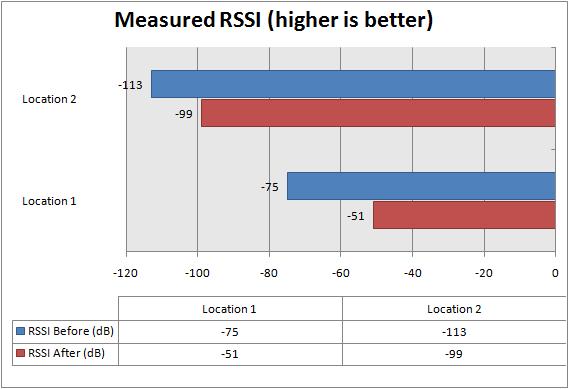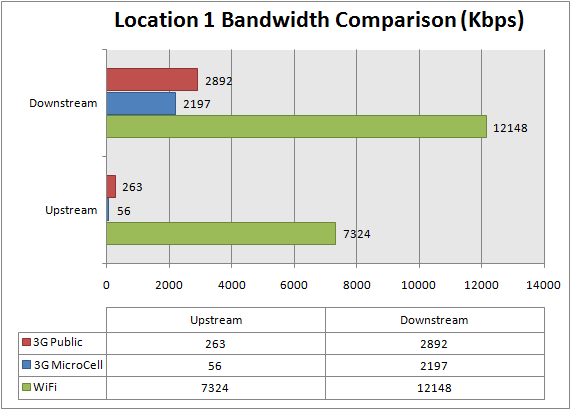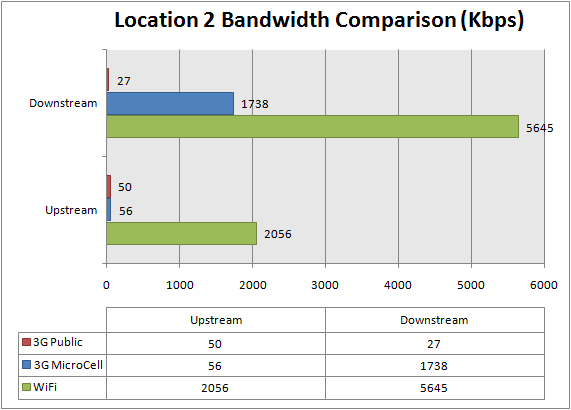AT&T 3G MicroCell: A Comprehensive Exploration
by Brian Klug on April 1, 2010 1:55 AM EST- Posted in
- Smartphones
- AT&T
- Microcell Review
- Mobile
Performance - Data
I noted a few times that I tried the device at two different residences, both for completeness sake and because they're completely different coverage-wise. Location one is relatively urban and already had excellent signal and performance; I regularly see speedtests over HSPA of nearly 5 Mbps. The internet connection here is a 20 Mbps downstream, 4 Mbps upstream DOCSIS 3.0 Cox Cable connection shared using a WRT54G-TM running Tomato. I sat in the same room as where the AT&T MicroCell was installed, my office. There's some irony in using T-Mobile's branded router (as it's sold expressly for UMA), however I use it because it has double the RAM and ROM of the WRT54GL.
Location two is more rural and doesn't have good performance or signal coverage; there are more than a few dead zones throughout the house, and I chose what I perceived to be the worst one. Internet here is Comcast Cable with 6.6 Mbps downstream, 1.1 Mbps upstream shared using a m0n0wall router running on a WRAP PC Platforms board.
I installed the microcell at both locations and let it sit for an hour. I assigned a static DHCP IP address, and then set that IP to maximum QoS priority for both upstream and downstream. For testing, I used four iPhone 3GSes, including my daily device, which is jailbroken so I can report RSSI. This is the relative signal strength reported by the baseband in arbitrary units, though still in dB. If you're rusty, remember that every factor of two change in power corresponds to 3 dB - if we go down 3 dB, we're at almost exactly half the signal. If we go up 3 dB, we're at double the power. In this case, RSSI is not dBm. As an aside, this is a much better way to gauge signal at a glance than the vague signal bar visualization; the iPhone seems to show a very optimistic moving average in its bar metric.
On the iPhone, -113 dB is effectively zero to one "bars." In fact, this seems to be the bare minimum in practice before the radio disconnects. Similarly, -51 is absolute maximum. If you put the phone next to the microcell, you'll see this, or if you're standing within line of sight very close to a macrocell. Thus in the following plot, closer to 0 is better.

For testing bandwidth, I ran tests using speedtest.net on the iPhone over 3G with and without the microcell, and over WiFi for a comparison point of my network bandwidth. Of course, we're limited to 802.11b (11 Mbps) rates on the iPhone over WiFi.


One thing that stands out doing lots of tests is that upstream performance is arbitrarily capped at exactly 58-60 kilobits/s on the MicroCell. Remember that 256 kilobits/s requirement earlier? It's obvious now where they derived that 60 kilobit/s cap from: 60 * 4 is roughly 240 kilobits/s. Add in some overhead fudge factor, and you've got 256 kilobits/s. So in the worst case, where there was previously almost no signal at all, we can now get a pretty speedy 3G data connection over the microcell. However, in the best case, at location 1, we're actually slower than before.
Remember again that AT&T's MicroCell currently only supports HSDPA speeds of up to 3.6 Mbps - at location 1 it's obvious that AT&T is running HSDPA at 7.2 Mbps, as I regularly see results like these:

Oh yeah, I'm always up that late doing bandwidth tests

Location 2 Before and After
But performance is still a function of signal strength even with the MicroCell. As you move away, you'll see speeds go from being ideal for HSDPA 3.6 Mbps all the way down to a respectable but less than ideal 1.2 Mbps.










63 Comments
View All Comments
Some1ne - Thursday, April 1, 2010 - link
So let me get this straight. I'm supposed to pay AT&T for access to a device that uses my own Internet connection to patch up holes in their network? That's just ridiculous. It's AT&T's inadequate network coverage that makes these devices necessary in the first place, and now they're actually trying to profit off of having poor network coverage. Pretty much removes any incentive for them to improve their network, now doesn't it?These devices should be provided free of charge, as a "sorry you can't actually use the network that you paid to access" kind of token. Anyone who pays for one of these is just giving AT&T one more reason not to fix their coverage issues.
Alexstarfire - Thursday, April 1, 2010 - link
I rather agree. Makes you wonder what they actually do with all the money they receive monthly. Also means that if you purchase one, much like how it should be if you use an unlocked phone, that your monthly bill should drop in price. Except in this case if they are using your broadband connection then it should practically be free since it provides next to no burden on them, though I don't know what happens after it goes through the connection.therealnickdanger - Thursday, April 1, 2010 - link
How do you know that the actual cost of the device and the technology driving it isn't already subsidized by your bill? Perhaps you're only paying 10% of what it really costs.vol7ron - Thursday, April 1, 2010 - link
Even if a subsidy were included, which would only cover some (not all) of the costs, the fact that people have to pay anything more for it is ridiculous given the nature of what a cell company is: a service. Cell phone companies are in business for one reason and by making you pay anything more to receive the core product is truely sad.There are other companies, like Cisco, that have built their own repeaters and Mobile-to-VOIP products, which I commend, because they are a technology company not providing the service. They're taking something bad, that they don't have control of, and making it bearable. Cell phone providers are at the other end, they have full control but are making you pay more, even though you aren't getting the initial benefit of what you're paying for in the first place.
zinfamous - Thursday, April 1, 2010 - link
This is kind of where I sit with the argument. a one-time ~$150 cost to the customer *may* be cheaper in the end, than having a network-wide upgrade that increases costs across all customers, paying more and more per month.Perhaps it also improves access to those willing, and needing increased network performance, paying a bit more for the premium, while those customers with little need for the bandwidth go on about their normal use, paying what they always have. It's like...a single-payer network structure! :D
DoeBoy - Thursday, April 1, 2010 - link
IT seems to me some people forget that companies are in business to make money. This is a great way for ATT to make a lot of extra money. I live in a rural area and i complain all the time in an area they say has coverage that does not at all. While this would aid me in getting better service it also would require me to pay for an inet connection which is not covered by att. Clearly they aren't a moral company when your service is so bad you have to have a product that uses some other technology(a la internet) and then charge the person not only for that product that gets you service but not even lower your bill since you technically arent using their towers really at all under this sucker. Clearly Verizon and ATT are both big 500lb gorillas. In europe its much easier to get a cheap cell phone deal and coverage. Clark Howard seems to think ATT and Verizon are going to end up being more corporate and smaller companies like t-mobile, cricket, metropcs and what not will fill in the void for the regular consumer.Some1ne - Thursday, April 1, 2010 - link
The problem is that when you look at the pricing matrix, not only is there a fixed upfront cost, there are also recurring monthly fees. It doesn't matter how much the up front cost is subsidized. The monthly fees mean that sooner or later, AT&T will be turning a profit on these devices.And even worse, the fees are higher if you're not already using AT&T as your ISP and/or land-line provider. That makes the least sense out of anything, since if you have a different ISP, then by running the femtocell you are completely unburdening AT&T's network, and dumping all the work onto someone else. The get to sell your bandwidth to someone else, and charge you more while doing it.
taltamir - Thursday, April 1, 2010 - link
in computers, the technology is made mostly of sand... it costs practically nothing.It is the technology you are paying for...
However there is one major component here, AT&T themselves look at it as a "cost cutting method"... in other words it is intended to cost them LESS, aka, they are making MORE of a profit on you if you get one of those then without.
The whole thing is absurd. You pay hundreds of dollars for a black box device with tamper protection and absolutely horrid performance (compared to wifi), then you pay a monthly fee for the privilege of using said device...
they should just put wifi in every device and have wifi be free (but they usually charge a monthly fee for that privilege as well)
ant1pathy - Friday, April 2, 2010 - link
You are, of course, welcome to change carriers. If you feel the service you are recieving is subpar and another carrier would be better for you, the termination fee is probably less than the cost of the box. If you're continuing to pay for a service that does not meet your needs and you can't really use, then you are the pefect consumer.Wolfpup - Wednesday, April 21, 2010 - link
I completely agree. It's absolutely nuts IMO.